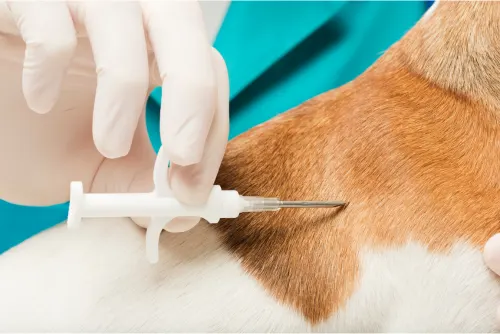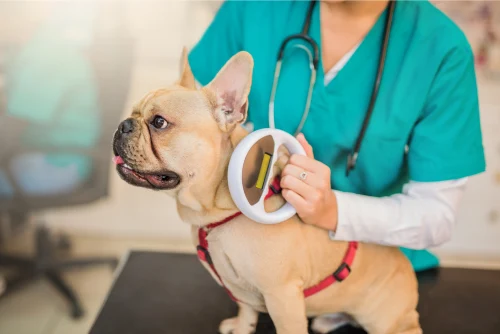Key Takeaways
– Cats are 21 times more likely to return home if microchipped
– Dogs are up to 3 times more likely to return home if microchipped
– Cats are up to 8 times less likely to be microchipped than dogs
– 41% of missing cats are considered indoor-only cats
– Unregistered or improperly registered pets are up to 4.9 times less likely to return home
– PetLink, HomeAgain, 24Petwatch are a few top choices for pet registries
– Microchipping a pet is safe and cheap at only a $25 – $50 one-time fee
– Microchips should accompany other forms of visual identification such as a dog tag or Byte Tag
– August 15 every year is National Check The Chip Day
– Check your pet’s registry annual at least once to verify accuracy
– Ask your vet to scan your microchipped pet annual
Importance of Pet Microchips
Did you know that a microchipped cat is 21 times more likely to be returned to its owner than a non-microchipped cat? A microchipped dog is 2-3 times more likely to be returned to its owner than a non-microchipped dog. Microchips truly change the game in bringing missing pets home.
In fact, studies worldwide—spanning the United States, Australia, Spain, the Czech Republic and beyond—show that microchipped dogs return home 54-80% of the time, while non-microchipped dogs return home only 21-42% of the time.
A study in the United States found that microchipped cats return home 38.5% of the time, while non-microchipped cats return home a heartbreaking 1.8% of the time.

For pet owners in Maine, these numbers are no different. Microchipped and non-microchipped cats in Maine return home 4.3% of the time. Microchipped and non-microchipped dogs in Maine return to their owners 19.4% of the time.
Just because we live in Maine with a relatively small population doesn’t mean our missing pet population is small. On average, Maine returns about 2,200 dogs home each year. About 750 cats return home each year. The good news for these missing pets that end up in a rescue or shelter is that over 80% of them adopt new families. That is great for the pet to receive such care. However, for a pet owner wondering the fate of their loved one, it proves haunting.
Microchipping our pets drastically increases their chances of remaining safety.
Cat Owners, Take Note
Microchips are even more crucial for cats, especially indoor cats. Why? Cats are curious escape artists. In 2020, 24Petwatch, one of several highly regarded microchip registries, found that 58% of their 42,000 lost pet reports were for cats. No specific data were available on how many of the 24,000 lost cats were indoor cats, but research from 2007 showed that 41% of reported lost cats were indoor-only cats. That is a staggering number of cats who get lost, but were never meant to leave their home. For the sake of your pet’s safety and wellbeing, consider microchipping and registering your cats, including indoor cats.
Cats are far less likely to microchipped than dogs. In Portugal, only 12% of cats have microchips, compared to 77% of dogs. The numbers for cats are even lower in places like Spain and Australia reaching as low as 3.2%. Overall, cats are between 3-8 times less likely to receive microchips than dogs.
What Is a Microchip?
According to the American Veterinary Medical Association (AVMA), a microchip is a small, electronic chip enclosed in a glass cylinder that is about the same size as a grain of rice. The microchip itself does not have a battery—it activates when a scanner that passes over the area, and the radio waves put out by the scanner activate the chip. The chip transmits the identification number to the scanner, which displays the number on the screen. The microchip itself is also called a transponder. More specifically, it is a passive transponder. Think of a credit card. It’s similar technology using radio frequency identification or RFID.
These chips, designed to last 25 years, work for all kinds of pets—including cats, dogs, rabbits, horses, and even llamas.
No matter the species, the purpose of a microchip remains the same—to aid in the return of a missing pet to the rightful owner.
The Importance of Pet Microchip Registration
Here’s the catch: a microchip alone does not suffice. Accurate and up-to-date microchip registration is essential. Pets with outdated or missing microchip registry information are 1.3-4.9 times less likely to make it back to their families. This is especially true when the owner’s contact information is missing or incorrect.
It turns out that in the United States, a minority of microchipped pets have proper microchip registrations. If you are a pet owner with a microchipped pet, this statistic should act as a catalyst to review your registry information. Only 58.1% of microchipped pets are registered. Of those, 30-40% have problems with their registry. That means only about 4 out of every 10 microchipped pets in the United States have proper microchip registration.
According to former AVMA President Dr. Rena Carlson: “An unregistered microchip is like a lighthouse with no light; its potential to guide is lost.” If you are unsure or have forgotten which registry or registries your pet(s) are associated with, try searching their 9, 10, or 15-digit ID using the AAHA Microchip Registry Lookup tool. This will tell you which participating companies your pet is registered with as well as the last date the registry was updated.
Best Microchip Registry
A microchip is only as effective as its registry. Many registries are available, like those participating in the AAHA Universal Pet Microchip Lookup Tool. There are currently 42 companies participating. A pro tip: When choosing where to register a microchip, always start with the microchip manufacturer. Why? Because according to a well-known research paper out of Ohio State University, “Typically personnel at animal shelters and veterinarian clinics only contact the microchip registry of the company that manufactured the microchip identified in an animal”. This problem certainly requires addressing. There is one thing you can do to start. To give your pet the best shot at identification, make sure you choose your microchip manufacturer’s registry first.
Top Microchip Registries
Other Microchip Registries To Consider
How Much Does It Cost To Microchip a Dog or Cat?

Microchipping typically costs $25-$50—a small price to pay for the peace of mind it offers.
Debunking Myths About Microchips
Myth: Microchips work like GPS.
Microchips don’t track your pet’s location. They store an ID number linked to your contact information. In fact, a microchip doesn’t contain a power source. A close-range scanner activates the microchip. The scanner emits a particular radio wave frequency that allows the scanner to retrieve the only piece of information stored on the microchip—a 9, 10, or 15-digit ID number. If you are interested in GPS tracking for your pet, consider the Apple AirTag.
Myth: Microchips can move around and get lost in the pet’s body.
While microchips can shift slightly, they remain in the subcutaneous tissue and scanners can still detect them. Typically, after 24 hours following implantation, the subcutaneous tissue around the microchip adheres to it, essentially locking it into place. The migration rate inside the body is very low at 1.6%, though another study reports the migration rate as low as 0.005%. This equates to about 1 out of every 200 microchips migrating slightly.
Myth: Implanting a microchip is extremely painful for pets and can cause other adverse reactions.

Implantation takes only a short time and causes minimal discomfort, similar to a routine vaccination. Adverse reactions to microchip implantation are about 0.01%.
The likelihood of an allergic reaction remains very low. The materials used in a microchip do not trigger allergic reactions.
Microchips are sterile; therefore, should not cause any infections. To reduce the risk of infections, ensure that licensed veterinarians perform the implantation.
The most commonly reported reaction after implantation is inflammation that disappears quickly.
People’s concerns about electrical shock to a pet are unfounded. Since the microchip lacks a power source and uses radio waves, it cannot create a painful shock.
Finally, microchips do not cause cancer, despite improper speculation. Researchers have not provided any legitimate evidence to suggest a connection. People reviewing studies using mice that show high rates of tumor formation often misinterpret the results and the poor experimental designs. Researchers breed mice for cancer research and therefore predispose them to developing cancer. No scientific evidence supports such a claim.
Myth: Microchips are only necessary for outdoor pets.
Indoor pets can escape, and microchips significantly increase the chances of them being reunited with their owners. Consider the issue of indoor cats mentioned above. 41% of missing cats reported are indoor-only cats.
Myth: A microchip is the same as a pet tracker.
Unlike GPS trackers, microchips don’t provide real-time location or health data; they serve as permanent identification. Once again, there is no technology or power source within the microchip to allow for any form of tracking.
Myth: Only dogs need microchips.
Cats and other pets, like rabbits, ferrets, horses, and llamas benefit from microchips, and they’re crucial for all species prone to escaping.
Myth: A microchip guarantees my pet will be returned if lost.
Microchips are only effective if registered with updated contact information in a pet recovery database. Even then, no method of identification is 100% accurate or reliable. The main takeaway is that a microchip drastically increases your chances of reunification with a lost pet, but does not guarantee it.
Myth: Shelters and vets can read any microchip.

While most universal scanners can detect and read various microchips, some scanners only read one of three frequencies—125 kHz, 128 kHz, and 134.2 kHz.
Common microchips include:
- PetLink Microchip
- HomeAgain Microchip
- 24Petwatch Microchip
The only ISO-certified frequency is 134.2 kHz, which is internationally recognized. If traveling internationally with a pet, check that your pet’s microchip meets the proper standards. If you pet’s microchip emits the wrong frequency, a scanner not searching for that particular frequency will not pick it up. The result could be no reunification for you and your missing pet. Even when scanners fail to detect the correct frequency, they have led to euthanizing pets. In one case, staff scanned a pet multiple times before euthanasia, but failed to detect its microchip. Staff euthanized the dog 30 minutes before its owner contacted the facility searching for their pet. If the proper scanner had been used, the outcome would likely have been different.
Myth: Microchips require regular replacement or maintenance.
Manufacturers design microchips to last 25 years, exceeding the life expectancy of many pets, and they require no internal power source or maintenance.
Myth: If my pet has a microchip, they don’t need a collar or tag.
Microchips serve as a backup while visible tags provide immediate information to anyone who finds your pet. Consider a physical tag including a Byte Tag. Remember that “Visual identification is the easiest method for pet reunification“. The addition of visual tags, such as an engraved tag or a Byte Tag, can prove vital for reunification. Many states do not mandate scanning pets for microchips. In the United States, animal control, animal shelters, or animal pounds in only 12 states, plus the District of Columbia, must scan animals at least once upon intake. Even if your pet has a microchip, local ordinances and an organization’s policies or capabilities in the remaining 38 states may prevent staff from scanning your missing pet. That is where the old-fashioned physical tag becomes useful.
Myth: Microchipping is too expensive.
The one-time cost is typically $25-$50, far less than the expense and stress of searching for a lost pet.
Myth: Scanning microchips invades privacy.
Microchips contain only a unique ID number, not personal information.
Myth: Microchips can malfunction or stop working.
While rare, microchips can fail; an annual scan at the vet ensures it’s functioning correctly.
Myth: Once microchipped, my pet is protected for life.
You must register the microchip and keep the registry details up-to-date for it to be effective.
Myth: Microchips are too large for small pets.
Microchips are small, about the size of a grain of rice, and safe for pets of all sizes.
Myth: All microchip registries are the same.
Registries vary in accessibility and features. Choose one participating in the AAHA Universal Pet Microchip Lookup Tool for better chances of reunification. In some countries, the veterinarian or animal shelter performing a microchip implantation will register the pet for you at the same time. However, in the United States, that is not necessarily the case. It is the owner’s responsibility to make sure they register their pet properly. In the case of adopting a pet with a previous owner, make sure you update the microchip registry with your information.
Microchip Tips
- First, ensure you microchip your pet and register it properly.
- Have your pet’s microchip scanned annually during a wellness checkup to ensure it’s functioning.
- Update your contact information immediately if you move or change phone numbers.
- Check your microchip registry at least once annual. August 15 of every year is National Check The Chip Day. This is a collaboration of the AAHA, AVMA, and HomeAgain.
- When traveling internationally, recognize that the international standard frequency is 134.2 kHz. If your pet’s microchip does not meet this standard when traveling abroad, scanners may not recognize it if your pet goes missing.
- For more information exploring pet safety and wellbeing, Burnell Pet Care and Education are releasing an online course in the near future taking you through topics sure to enhance your lives as much as your pets’ lives.
Conclusions
As mentioned above, while microchips provide incredible value, they’re not a replacement for visible ID tags. Combining both methods maximizes your pet’s chances of a safe return.
By investing in a microchip and maintaining its registry, you’re giving your pet the best chance of finding their way home if they ever become a missing pet. It’s a simple step that could make all the difference.